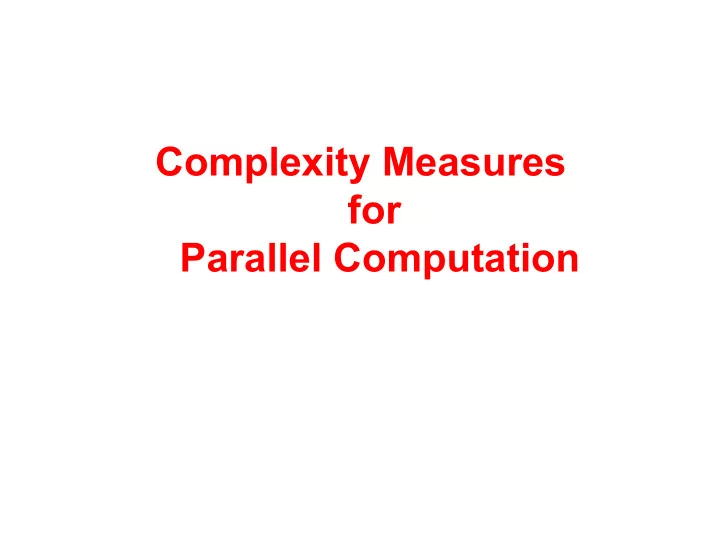

Complexity Measures for Parallel Computation
Complexity Measures for Parallel Computation Problem parameters: • n index of problem size • p number of processors Algorithm parameters: • t p running time on p processors • t 1 time on 1 processor = sequential time = “work” • t ∞ time on unlimited procs = critical path length = “span” • v total communication volume Performance measures • speedup s = t 1 / t p • efficiency e = t 1 / (p*t p ) = s / p • (potential) parallelism pp = t 1 / t ∞ • computational intensity q = t 1 / v
Several possible models! • Execution time and parallelism: • Work / Span Model • Total cost of moving data: • Communication Volume Model • Detailed models that try to capture time for moving data: • Latency / Bandwidth Model (for message-passing) • Cache Memory Model (for hierarchical memory) • Other detailed models we won ’ t discuss: LogP, UMH, … .
Work / Span Model t p = execution time on p processors
Work / Span Model t p = execution time on p processors t 1 = wo work
Work / Span Model t p = execution time on p processors t 1 = wo work t ∞ = sp span an * * * Also called criti tical-path th length th or computa tati tional depth th .
Work / Span Model t p = execution time on p processors t 1 = wo work t ∞ = sp span an * * W ORK ORK L L AW AW ∙ t p ≥ t 1 /p S PAN PAN L L AW AW ∙ t p ≥ t ∞ * Also called criti tical-path th length th or computa tati tional depth th .
Series Composition A B Work: Work: t 1 (A ∪ B) = Work: Work: t 1 (A ∪ B) = t 1 (A) + t 1 (B) Sp Span: Sp Span: n: t ∞ (A ∪ B) = t ∞ (A) +t ∞ (B) n: t ∞ (A ∪ B) =
Parallel Composition A B Work: Work: t 1 (A ∪ B) = t 1 (A) + t 1 (B) Sp Span: n: t ∞ (A ∪ B) = max{t ∞ (A), t ∞ (B)}
Speedup Def. t 1 /t P = sp De speed eedup up on p processors. If t 1 /t P = Θ (p), we have lin linear speedu ear speedup , = p, we have perfect t linear speedup , > p, we have sup superlinear erlinear sp speed eedup up , (which is not possible in this model, because of the Work Law t p ≥ t 1 /p)
Parallelism Because the Span Law requires t p ≥ t ∞ , the maximum possible speedup is t 1 /t ∞ = (potential) parallelism = the average amount of work per step along the span.
Laws of Parallel Complexity • Work law: t p ≥ t 1 / p • Span law: t p ≥ t ∞ • Amdahl’s law: • If a fraction f, between 0 and 1, of the work must be done sequentially, then speedup ≤ 1 / f • Exercise: prove Amdahl’s law from the span law.
Communication Volume Model • Network of p processors • Each with local memory • Message-passing • Communication volume (v) • Total size (words) of all messages passed during computation • Broadcasting one word costs volume p (actually, p-1) • No explicit accounting for communication time • Thus, can ’ t really model parallel efficiency or speedup; for that, we ’ d use the latency-bandwidth model (see later slide)
Complexity Measures for Parallel Computation Problem parameters: • n index of problem size • p number of processors Algorithm parameters: • t p running time on p processors • t 1 time on 1 processor = sequential time = “work” • t ∞ time on unlimited procs = critical path length = “span” • v total communication volume Performance measures • speedup s = t 1 / t p • efficiency e = t 1 / (p*t p ) = s / p • (potential) parallelism pp = t 1 / t ∞ • computational intensity q = t 1 / v
Detailed complexity measures for data movement I: Latency/Bandwith Model Moving data between processors by message-passing • Machine parameters: • α or t startup latency (message startup time in seconds) • β or t data inverse bandwidth (in seconds per word) • between nodes of Triton, α ∼ 2.2 × 10 -6 and β ∼ 6.4 × 10 -9 • Time to send & recv or bcast a message of w words: α + w* β • t comm total commmunication time • t comp total computation time • Total parallel time: t p = t comp + t comm
Detailed complexity measures for data movement II: Cache Memory Model Moving data between cache and memory on one processor: • Assume just two levels in memory hierarchy, fast and slow • All data initially in slow memory • m = number of memory elements (words) moved between fast and slow memory • t m = time per slow memory operation • f = number of arithmetic operations • t f = time per arithmetic operation, t f << t m • q = f / m ( computational intensity) flops per slow element access • Minimum possible time = f * t f when all data in fast memory • Actual time • f * t f + m * t m = f * t f * (1 + t m /t f * 1/q) • Larger q means time closer to minimum f * t f
Recommend
More recommend